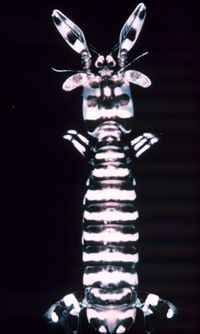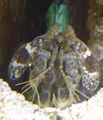Mantis shrimp (Lysiosquillina maculata)
From The Aquarium Wiki
(Redirected from Gonodactylus smithii)
Mantis shrimp
Lysiosquillina maculata
38 Litres (10 US G.)
7.6-15.2cm (3-6 ")
8.1 - 8.4
22.2-25.6°C (72 -78 °F)
8-12 °d
1:1 M:F
4-6 years
Contents
Alternative names[edit]
- Mantis Shrimp, Thumbsplitter
Species Note[edit]
- The Mantis shrimp is frequently considered an aquarium pest. They are frequent hitchhikers on live rock and will kill aquarium stock. They are becoming increasingly popular as a Saltwater pet. Keeping a mantis is one of the cheapest types of saltwater aquariums
Sexing[edit]
- You can sex a mantis by looking at its tail from below when it is backed up against the glass. If it has two small sticks sticking inwards, it is a male. If it has two spots close together, it is a female. Some types of mantises can be sexed by colour.
Tank compatibility[edit]
- Only one mantis shrimp per tank. If well fed, smashing mantises can be kept with fast fish that swim in water column (CAUTION!)
Diet[edit]
- Mantis shrimp are carnivorous. Smashers will eat small hermit crabs and snails. Smashers may eat fish, but usually won't if food is plentiful. Spearers eat fish. The diet of either may be supplemented with frozen shrimp and squid, preferably soaked in nutrients like selcon.
Feeding regime[edit]
- Most species can survive 2-3 weeks without food, but it is suggested to feed two times a week to one time a day. Can be fed live foods such as crabs and snails, or in case of spearer, fish. Suggested to feed frozen foods such as shrimp and squid soaked in nutritional supplements such as selcon.
- If the Mantis shrimp refuses to eat frozen foods then, do not feed it for up to two weeks. Every day stick the food (on a stick or skewer) into the tank and swish it in front of the shrimp and wave it outside its burrow, or even prod it with the food lightly. If after two weeks it will still not eat, put in some food it will eat such as crabs, snails, or if it is a spearer, fish. Try again in a week. Smasher type mantis shrimp need a little bit of hard shelled food to keep their raptorial appendages (smashing claws) in shape. This is especially important to the survival of Odontactylus Scyllarus, the Peacock Mantis Shrimp, because it is prone to shell disease and moulting problems.
Environment Specifics[edit]
- This animal requires calcium to facilitate moulting. It also needs a burrow. An appropriately sized live rock will work for smashers (it will make a hole if there is not one available) or a PVC pipe about 1.5X the width of the mantis. Smaller smashers can house in large shells. Spearers also require a burrow. A spearer should be housed in a tank with a sand bed as deep as it is long. It will require a PVC pipe 1.5X the width of the mantis in a "U" shape. It should be buried in the sand at a 90-degree angle with both holes at the top of the sand and be as tall as the mantis is long. Some harder to keep spearers may require mud to make a burrow, which can cause water problems. Some Mantises may require a chiller to survive. Mantis Shrimp can't stand strong lights as it will cause shell rot and moulting problems. It also requires good flow to prevent shell disease and preferably a protein skimmer. Smashers that live above 10 meters deep can stand full strength light.
- Smashers larger than 15.2cm (6") can break aquarium glass, though it is unlikely unless it is taunted. It may break it digging, though, which is why a large smasher should be housed in an acrylic aquarium, or have acrylic put under the substrate and some acrylic strips in the corners.
Behaviour[edit]
- Only one Mantis Shrimp should be kept in a tank. It will fight with and sometimes kill members of its own species and many other livestock. In much larger tanks, two mantises may be kept together. Some spearers will mate for life. Some urchins and sea stars can be kept with caution also. It depends on the mantises' personalities.
Identification[edit]
- You should not depend on the store's classification. It is necessary to identify it yourself. A useful link for this is Dr. Roy's list which helps you identify most mantises commonly sold in aquariums. The first step to identifying the mantis is to figure out if it is a smasher or a spearer. Smashers smash their prey, and spearers will spear soft bodied prey. If you hear a clicking noise, it is probably a smasher. If you notice fish missing, it is probably a spearer. Next is its size, colour, and then, if you know, where it came from. Dr. Roy's list is in external links.
Pictures[edit]
Videos[edit]
Large Adult Mantis:

